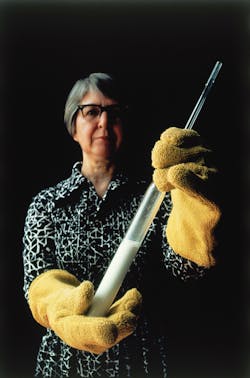Madame Kevlar and the scientific discovery that save(s) thousands of LEO lives
Madame Kevlar and the scientific discovery that save(s) thousands of LEO lives
A daughter of working-class Polish immigrants went on to discover what Fortune magazine once dubbed “The miracle in search of a market”. Dr. Stephanie Kwolek passed away (date). But her life-saving legacy lives on. Kwolek’s years of labor discovering the material Kevlar was a boon to many, but perhaps none so much as men and women law enforcement officers who don the ballistic vest to go to work. Since the 1970s when Kevlar was put to use in public safety body armor, about ten years after Kwolek’s initial discovery, about 3,000 officers have been save from bullet wounds through the use of equipment reinforced with Kevlar, a material far stronger than steel.
Lab days
Not too long ago the necessity to replace natural rubber and alternatives to glass paved the way for modern polymer science. “Kevlar…is one of the most important polymer materials and fibers that belong to the class of polymers called aramids,” says Rigoberto Advincula, Ph.D., Associate Chair and Graduate Chair of the Department of Macromolecular Science and Engineering at Case Western Reserve University in Cleveland.
In the mid-1960s Kwolek, at her DuPont lab, was struggling to convert a solid polymer into a liquid form. She expected to get a syrupy mixture—something that was viscous and clear but she kept getting an opaque substance. She and her colleagues then did a process called “spinning”. This is how DuPont would make fibers like nylon.
“When you do that spinning, you want to think of it as a kind of centrifuge,” says David M. Manuta, Ph.D, FAIC (spell out) and president of Manuta Chemical Consulting, Inc. There’s a kind of separation; the liquid is removed and what’s left behind are the polymers. If you can get them to line up just so, in what we call an “orientation effect”, you can make them as strong as you want.
After about 15 years of laboring with the substance Kwolek was able to get the polymers to line up in parallel, and when the liquid was cold spun it produced a fiber of unusual stiffness. 1965 tests found this new substance, in which all the polymers aligned, was five times as strong as steel, of equal weight, and resistant to fire.
Kwolek told USA Today in 2007 “I never in a thousand years expected that little liquid crystal to develop into what it did”.
As a young adult just stepping into the work world, Kwolek had little formal education compared with the majority of company-hired scientists today. Without adequate funds to cover tuition to medical school, her first career choice, Kwolek began work in DuPont in 1946 armed with a bachelor’s degree from Pittsburgh’s Carnegie Institute of Technoogy.
The New York Times reported Kwolek was excited to go to work every day at the DuPont lab, where she worked for 15 years without a promotion before her breakthrough. Kwolek did not benefit financially from her discovery, but signed over patent royalties to DuPont.
“Marketing personnel at DuPont then embraced the challenge of finding applications for this unique formulation,” says Manuta.
Ellen Kullman, DuPont Chair and CEO called the groundbreaking scientist “a creative and determined chemist and a true pioneer for women in science”. In 1996 she became the company’s third scientist to win a National Medal of Technology of Science, just one of many accolytes. She was also an American Institute of Chemists (AIC) Chemical Pioneer awardee in 1980 (DM), and in 1996 was awarded the National Medal of Technology among numerous other acolytes.
The thread that stops the bullets
Ballistic protection has come a long way since the early days of Kevlar. Today’s carriers are fitted with ceramic plates, and military helmets with up to 24 layers.
Dr. Advincula says while aramids are the most important classes of polymers used for ballistic protection, there are many other polymers that can be found in law enforcement, including polycarbonates, polypropylene, high density polyethylene (HDPE), nylon, polyurethane, etc. “Other uses include vest, helmets, textiles, visor, non-flammable vests or clothing, holsters, gun handles…even polymers that find their way in explosive (shape charges). “Properties based on light weight, high mechanical strength relative to weight, non-flammability, durability are always excellent properties for new functions and needs in law enforcement applications.”
Manuta impressed with ongoing innovations in this field—say, specialized clothing developed for soldiers and personnel in Iraq and Afghanistan that circulate fluids, keep them cool and protected. Still, he says, it’s tough to make an apples to apples comparison.
Manuta’s says Kwolek was “one-of-a-kind”…especially for her time. “People like me, we judge science fairs and we’re old enough to remember when almost no young women were going into science. As we mentor young people, we want to remember there are a lot of talented young ladies. What a fantastic role model somebody like Dr. K would be.
In her later years, Kwolek was passionate about mentoring young women in the science fields.
New horizons
The minute in stature (4’11”) Kwolek passed away at 90. But imagine what her brilliant mind could have left behind. Says Manuta: “If we were to look at her research notebooks there may be a dozen other innovative idesas where people have becked up on them. That’s part of the legacy and the importance that we honor people in their lifetimes.”
DuPont announced [sale] of its one millionth vest the very day Ms. Kwolek passed.
She never forgot where she came from. Manuta: “You don’t have to be a bright guy coming out of MIT to make important inventions, but just somebody who plugs away…and realizes ‘there’s something interesting going on here; let’s see what we can do with it’”.
Kwolek was (physically, at least) much like her invention……(finish this sentence)
About the Author

Sara Scullin
Sara Scullin was the Editor of Law Enforcement Technology magazine, a monthly business-to-business publication that covers technology trends and best practices for public safety managers. LET is part of SouthComm Law Enforcement Media, which also publishes Law Enforcement Product News and Officer.com. Sara had covered the law enforcement industry since March 2008.
